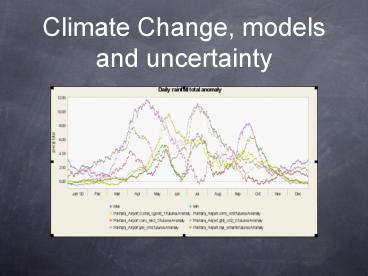Climate Change, models and uncertainty - PowerPoint PPT Presentation
1 / 21
Title:
Climate Change, models and uncertainty
Description:
Climate Change, models and uncertainty ... – PowerPoint PPT presentation
Number of Views:302
Avg rating:3.0/5.0
Title: Climate Change, models and uncertainty
1
Climate Change, models and uncertainty
2
Confusing terms?
- Climate Change
- IPCC Climate change may be due to natural
internal processes or persistent anthropogenic
changes - UNFCCC A change in climate which is attributed
directly or indirectly to human activity and
which is in addition to natural climate
variability
3
Weather or Climate?
- Weather The local state of the atmosphere on a
day-to-day basis. Wind, rain, cold, hot - Climate Long-term average of temperature,
precipitation, extremes and other variables.
Different scales and different periods. - Climate sets the background conditions for
weather and will affect the frequency of certain
weather events.
4
Climate Change or just Climate Variability?
- Anthropogenic climate change is a significant and
persistent change in the average conditions or
extremes of a region. - But the climate system contains natural cycles
and variability seasonal, inter-annual (e.g.
ENSO, Indian Dipole), multi-decadal (e.g. North
Atlantic Oscillation) or longer!
5
- El Niño Global effects
- Every 3-7 years
- Warm and dry in Asia
- Drought
6
Variability happens
- A particularly hot/wet year in a particular place
isnt necessarily evidence of climate change. - A particularly cold winter isnt evidence that
climate change isnt happening - What is, however, is changes to the average over
time, and all of these observations taken
together and across the world. - Natural climate processes cannot explain the
global changes that we have observed in the last
50 years.
7
Current trends and climate projections
- Changes experienced now may be due to climate
change but may also be part of natural cycles - Just because it is getting wetter in a particular
location, doesnt necessarily mean this will
continue - If the observed trend matches the climate
projection, we can be more confident of the
changes to expect.
8
Context before projection!
- It is (really!) important to understand the
current climate context before jumping into
projections - What are the historical conditions?
- Are there any trends?
- Why are things the way they are?
- Without the context it is difficult to place the
projections. . .
9
Climate Projections and uncertainty
- We do not know what the future holds. . .but this
doesnt mean we cant do anything
10
Background
- A model is a representation of the real world, it
is not an exact copy - Projections vs Predictions.
- We do not know which model is best fit to
historical climate is not necessarily an
indicator of quality of projection - Climate is a complex system there are a range
of plausible future states
11
Types of Model pros and cons
- Global models (smallest resolution 200km)
- Regional Models (25-50km)
- Statistically Downscaled models (station level)
12
Global models
- Coarse resolution
- Good at capturing circulation changes
- Good for ideas of global change
- Skill decreases at smaller scales, which is where
we need information for adaptation! - Topography and feedbacks are problems
13
Where is this?
14
Regional Models
- Better resolution (up to 25-50km2)
- Good at a national/water basin level.
- Can model feedbacks.
- Provide information for whole region
- Computer intense so difficult to run lots of
models hard to look at a range of change. - Topography a problem
15
- Statistical Downscaling from large-scale to the
local.
16
Statistically downscaled models
- Provide projections at the level of an adaptation
activity. - Good at topography and islands
- Computer light, so can look at many different
projections and assess the range. - Cant provide data where there is not a good
historical record (at least 10 years continuous) - Cant capture feedback processes.
17
Station level projections
- Over 300 in Asia
- More expected through the platform
18
Confidence in projections
- Uncertainty emissions, models, processes, (e.g.
El Niño), land use. Variability will continue. - Projections should be treated as indicative, not
predictions. - More confident on certain variables than others
- The more models and data sources agree, the more
confident we can be. Including trends!
19
What we cant say
- A specific year will be bad
- We are certain of our projections
- Exact timing of changes
- Much detail about variability
- Much about the next 25 years
20
So. . .
- Multiple sources of information give us a more
rounded view - We cant simply discard information from a model
giving us a result we dont like - An average can hide valuable information the
extreme projection could be the right one - In the real world decisions made under imperfect
conditions all the time the key is what
information we can use to help the decision.
21
Thank-you!
- Ben Smith, Stockholm Environment Institute
bensmith.sei_at_gmail.com - www.weadapt.org www.wikiadapt.org

